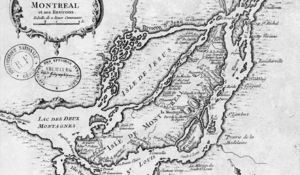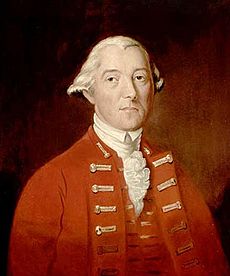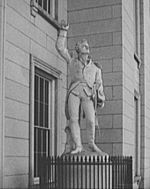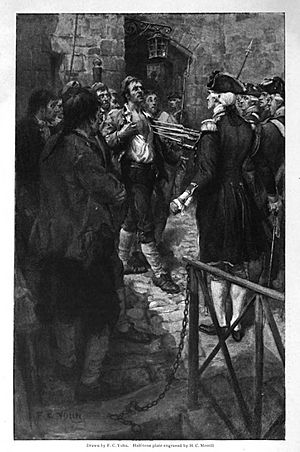Battle of Longue-Pointe facts for kids
Quick facts for kids Battle of Longue-Pointe |
|||||||
|---|---|---|---|---|---|---|---|
| Part of the American Revolutionary War | |||||||
 The Isle of Montreal in 1764. Longue Pointe is opposite Longueuil, which is on the right side of the map. |
|||||||
|
|||||||
| Belligerents | |||||||
| Commanders and leaders | |||||||
| Ethan Allen (POW) | Guy Carleton John Campbell |
||||||
| Strength | |||||||
| 37 Americans 60 Canadians |
34 regulars 80 British militia 120 Canadian militia 20 Indian agents A few natives |
||||||
| Casualties and losses | |||||||
| 6 killed 10 wounded 20 Americans, 11 Canadians surrendered Remaining force scattered |
5–8 casualties | ||||||
The Battle of Longue-Pointe (French: Bataille de Longue-Pointe) happened on September 25, 1775. It was an early event in the American Revolutionary War. During this battle, a famous American leader named Ethan Allen tried to capture Montreal from the British. He led a small group of American and Canadian fighters.
Allen had been told to only gather local fighters, but he really wanted to take Montreal. The city was not very well defended. When he reached the southern shore of the St. Lawrence River with about 110 men, he decided to try. His plan relied on Major John Brown bringing more fighters. However, Brown did not show up. This left Allen and his men alone on the north side of the river.
British General Guy Carleton heard about Allen's crossing. He quickly sent a force, mostly made up of local Canadian fighters. This force surrounded Allen's group, cutting off their escape. Allen and many of his men were captured. General Carleton later left Montreal, and the city was taken by American forces without a fight on November 13. Allen was sent to England and then New York City as a prisoner. He was later set free in 1778.
Contents
Why Did the Battle of Longue-Pointe Happen?
In the 1700s, Montreal was a much smaller city. The eastern part of the island of Montreal was called Longue-Pointe. There was once a fort there, across the river from Longueuil. Today, this area is part of Montreal.
When the American Revolutionary War began, many Americans thought it would be easy to get the people of Quebec to join their side. Quebec had only been taken by the British in 1759. Some believed the people there were unhappy with British rule. The American invasion of Quebec started on September 4, 1775. General Philip Schuyler led the American Continental Army to Île aux Noix.
General Schuyler became ill and gave command to General Richard Montgomery. Montgomery ordered his army to besiege Fort Saint-Jean on September 18. This fort was south of Montreal on the Richelieu River. General Guy Carleton had gathered most of his few British soldiers there.
American Plans and Hopes
Before getting sick, General Schuyler wrote a message to the people of Quebec. He asked them to fight the British and help the American cause. On September 8, Ethan Allen and Major John Brown traveled between Saint-Jean and Montreal. They spread this message. They met with James Livingston, who supported the Americans, and local Caughnawaga Mohawk people. Livingston later gathered about 300 local fighters. Allen and Brown then returned to Île aux Noix.
Allen had always wanted to capture Montreal. In May 1775, he and Benedict Arnold captured Fort Ticonderoga. After that, Allen took some men north to Saint-Jean, hoping to surprise the fort and then take Montreal. British soldiers arrived at Saint-Jean in time, stopping his plan. But this adventure made Allen well-known in Montreal and the Richelieu valley.

British Defenses in Montreal
After Fort Ticonderoga was captured in May 1775, General Carleton had only about 800 regular soldiers to protect all of Quebec. He sent about 500 soldiers, plus 250 local fighters and Native Americans, to Fort Saint-Jean. The rest were spread out in other forts. Montreal, Trois-Rivières, and Quebec City had very small groups of soldiers.
During the summer of 1775, Carleton tried to get more local people to join his fighting forces. This did not work very well. American messages and actions by American supporters like Thomas Walker and James Livingston made it hard. By July, Carleton seemed happy with the local support near Montreal. But he did not do much to stop the American supporters. These supporters also sent information about British plans to the Americans.
The Plan to Attack Montreal
When General Montgomery began the siege of Fort Saint-Jean, he gave orders to Allen. Allen and about 30 Americans were to join Livingston's Canadian fighters. Their job was to protect the south bank of the St. Lawrence River. This would stop Carleton from Montreal from sending help to the besieged fort. Montgomery also ordered a larger force, led by Brown, to secure the area north of the fort. Brown was also to cover the road between Saint-Jean and Montreal.
Allen traveled along the southeastern banks of the Richelieu River. He went up to Sorel, crossed that river, and continued along the southern shore of the St. Lawrence to Longueuil. Allen later said he met Brown there. Together, they made a plan to attack Montreal. Brown would cross the river with 200 men at La Prairie, which was upriver from Montreal. Allen, with his Americans and 80 Canadians, would cross the river at Longueuil, below the city. After a signal, both groups would meet in the city.
The Attack on Longue-Pointe
Allen and his men crossed the St. Lawrence on the night of September 24. They landed at Longue-Pointe. The people they met there seemed friendly. Allen placed guards on the road to Montreal. He wanted to stop news of their crossing from reaching the city. However, one man they stopped managed to escape. He reached the city and told Carleton that Allen was on the island.
Major Brown did not cross the river. No one knows for sure why Brown failed to act. Some historians think Allen acted alone and later blamed Brown for the plan's failure. This left Allen's group alone and in danger. It had taken three trips with the available boats to get his men across the river.
Allen realized he could not get everyone back across the river before British troops arrived. He chose a wooded area near Ruisseau-des-Sœurs to make a stand. This spot was between Longue-Pointe and Montreal. He also sent a message to Thomas Walker for help. Walker was a British merchant and an American supporter. Walker gathered some men, but Allen was captured before they could help.
When General Carleton heard that Ethan Allen was near the city, he quickly raised the alarm. Many people came out to help. Captain John Campbell gathered a force. It included 34 regular soldiers (the entire group in Montreal), 120 Canadian fighters, 80 English fighters, 20 British Indian agents, and a few Native Americans. He led them out to face Allen's group.
As Campbell's force came closer, Allen told 10 Canadians to protect his left side. He placed Duggan and 50 other Canadians on his right side. Both of these groups ran away instead of holding their positions. This left Allen with only about 50 men. For the next 90 minutes, the two sides exchanged fire. Allen's remaining men were eventually defeated. After trying to run away, Allen surrendered.
What Happened Next?
The failed attack on Montreal caused all the local fighters in Montreal to gather. Nearly 1,000 men joined, but they soon started to leave. Carleton refused to send help to Fort Saint-Jean. The local fighters from the countryside eventually went home to harvest their crops and protect their own families. In November, the fort's commander gave up. This opened the way for the Americans to reach Montreal. Carleton fled the city and went to Quebec City. General Montgomery took control of Montreal without a fight on November 13.
Allen and the other captured men were brought to the city. Allen later wrote that Colonel Richard Prescott wanted to kill the captured Canadians. But Allen stepped in to protect them. He said, "I am the sole cause of their taking up arms." Allen was put in a ship's storage area. He was eventually sent to England. He spent about a year, mostly on prison ships. He was released in British-controlled New York City in November 1776. The British did not want to hang him because they feared he would become a hero. He was eventually traded for a British officer in May 1778. Allen then continued his military and political work for the new Republic of Vermont.
Thomas Walker, the merchant Allen had asked for help, was arrested in early October 1775. Twenty soldiers and a dozen local fighters came from Montreal to his house. Walker's house was destroyed, and he was put in prison. The British planned to send him to England for trial. Walker was eventually freed when the Americans captured Montreal. They also captured most of the British ships trying to escape the city.
Remembering the Battle
Ethan Allen wrote a book about his capture and time in prison. This book, along with his other writings, was very popular in the 1800s. It was printed many times. There is a city park in Montreal called Parc de la Capture-d'Ethan-Allen. This park is in the area where the battle took place.
Images for kids




